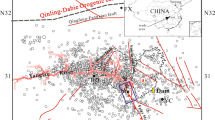Abstract
Yucca Mountain, the proposed site for the high-level nuclear waste repository, is located just south of where the present water table begins a sharp rise in elevation. This large hydraulic gradient is a regional feature that extends for over 100 km. Yucca Mountain and its vicinity are underlain by faulted and fractured tuffs with hydraulic conductivities controlled by flow through the fractures. Close to and parallel with the region of large hydraulic gradient, and surrounding the core of the Timber Mountain Caldera, there is a 10- to 20-km-wide zone containing few faults and thus, most likely, few open fractures. Consequently, this zone should have a relatively low hydraulic conductivity, and this inference is supported by the available conductivity measurements in wells near the large hydraulic gradient. Also, slug injection tests indicate significantly higher pressures for fracture opening in wells located near the large hydraulic gradient compared to the opening pressures in wells further to the south, hence implying that lower extensional stresses prevail to the north with consequently fewer open fractures there. Analytical and numerical modeling shows that such a boundary between media of high and low conductivity can produce the observed, large hydraulic gradient, with the high conductivity medium having a lower elevation than the water table. Further, as fractures can close due to tectonic activity, the conductivity of the Yucca Mountain tuffs can be reduced to a value near that for the hydraulic barrier due to strain release by a moderate earthquake. Under these conditions, simulations show that the elevation of the steady-state water table could rise between 150 and 250 m at the repository site. This elevation rise is due to the projected shift in the location of the large hydraulic gradient to the south in response to a moderate earthquake, near magnitude 6, along one of the major normal faults adjacent to Yucca Mountain. As the proposed repository would only be 200–400 m above the present water table, this predicted rise in the water table indicates a potential hazard involving water intrusion.
Similar content being viewed by others
Author information
Authors and Affiliations
Additional information
Received: 7 June 1996 / Accepted: 19 November 1996
Rights and permissions
About this article
Cite this article
Davies, J., Archambeau, C. Geohydrological models and earthquake effects at Yucca Mountain, Nevada. Environmental Geology 32, 23–35 (1997). https://doi.org/10.1007/s002540050190
Issue Date:
DOI: https://doi.org/10.1007/s002540050190




